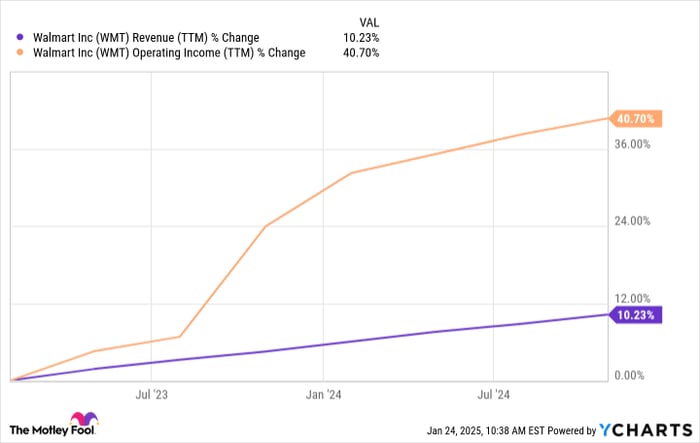
Shares of retail giant Walmart (NYSE: WMT) were up a whopping 72% in 2024. To put the magnitude of this move in perspective, this was the best year for Walmart stock since 1998 — you read that right. And its 72% return handily outperformed the S&P 500‘s otherwise stellar gain of 23%.
It’s been 25 years since Walmart’s shareholders had this good of a time. And that statement should have investors asking why.
Where to invest $1,000 right now? Our analyst team just revealed what they believe are the 10 best stocks to buy right now. See the 10 stocks »
I believe there’s an undeniable relationship between Walmart’s stock price and its surging operating income. Since the start of 2023, operating income has dramatically improved, as the chart below shows.
WMT revenue (TTM) data by YCharts; TTM = trailing 12 months.
What’s causing this? In the earnings call to discuss financial results for the third quarter of 2024, CEO Doug McMillon had this to say:
Globally, we drove strong growth in e-commerce, up 27%. Advertising grew 28%, and membership income was up 22%. This helped us grow profits faster than sales.
McMillon says that Walmart’s profits are surging because of growth in e-commerce, advertising, and membership income. These (related) things are the key to understanding the recently skyrocketing stock price and the key to understanding whether the good times for investors can continue.
How are these three things helping Walmart?
Management launched its membership program Walmart+ in 2020, and it has seen tremendous growth since. According to financial media outlet PYMNTS, Walmart+ already had over 60 million subscribers in September 2022. And according to the company, it’s continued on a double-digit growth rate since then. Therefore, it wouldn’t be surprising if it’s already knocking on the door of 100 million subscribers.
If people buy online and pick up at the store, the company counts it toward its e-commerce sales. Walmart+ subscribers have an incentive to use this service or to have items delivered to their homes. In other words, e-commerce growth has been boosted by growth in the membership program.
Getting more people transacting with Walmart digitally has been a boom for the company. The retailer opens up its e-commerce platform to third-party sellers, just like rival Amazon. Moreover, it’s able to generate advertising revenue unlike ever before.
In summary, Walmart is growing its digital business. People are paying membership fees, third-party merchants pay a cut of their own online sales, and advertisers pay to get in front of the company’s customers. This digital growth is higher-margin and is consequently driving rapid growth for operating income, lifting the stock price to its biggest gain since 1998.
Can these things keep helping Walmart?
Given its incredible performance in 2024, it would be tempting to assume that Walmart stock is now overvalued. But that assumption would be premature. Looking at the 10-year chart, the shares have averaged a price-to-earnings ratio (P/E) of 28, which is the P/E valuation for the S&P 500 right now, according to YCharts.
As the chart below shows, Walmart stock is more expensive than its own average or the average for the S&P 500. But it’s also enjoying better-than-average profit growth right now, which justifies a higher valuation.
WMT PE ratio data by YCharts.
In light of this, I’d say that Walmart’s valuation, though higher than usual, isn’t necessarily a concern. The bigger question is whether profit growth will continue to outpace revenue growth in 2025 and beyond.
I believe that this will indeed continue for the next year, at least. Investors should consider that the catalysts for 2024 — e-commerce, advertising, and membership income — are still growing at a strong pace.
Circling back to McMillon, third-quarter revenue for advertising, e-commerce, and membership income were all up more than 20%. Growth rates such as this usually don’t abruptly hit a wall. Rather, if there’s a slowdown, growth tends to taper off gradually.
Because of this, it’s reasonable to expect at least an ongoing double-digit growth rate in the three aforementioned areas, which will keep boosting profits. And this is assuming its digital growth has already peaked.
But keep in mind that the company is still early in its digital journey. Therefore, it’s possible that growth in some of these areas could actually hold steady, if not accelerate further.
To be clear, I don’t think that Walmart will come close to posting another 72% gain in 2025. That said, growth in the digital component of its business is strong, and that will be positive for profits in 2025. For this reason, I believe the stock could indeed outperform the S&P 500 again in 2025.
Don’t miss this second chance at a potentially lucrative opportunity
Ever feel like you missed the boat in buying the most successful stocks? Then you’ll want to hear this.
On rare occasions, our expert team of analysts issues a “Double Down” stock recommendation for companies that they think are about to pop. If you’re worried you’ve already missed your chance to invest, now is the best time to buy before it’s too late. And the numbers speak for themselves:
-
Nvidia: if you invested $1,000 when we doubled down in 2009, you’d have $369,816!*
-
Apple: if you invested $1,000 when we doubled down in 2008, you’d have $42,191!*
-
Netflix: if you invested $1,000 when we doubled down in 2004, you’d have $527,206!*
Right now, we’re issuing “Double Down” alerts for three incredible companies, and there may not be another chance like this anytime soon.
*Stock Advisor returns as of January 21, 2025
John Mackey, former CEO of Whole Foods Market, an Amazon subsidiary, is a member of The Motley Fool’s board of directors. Jon Quast has no position in any of the stocks mentioned. The Motley Fool has positions in and recommends Amazon and Walmart. The Motley Fool has a disclosure policy.



